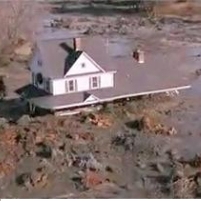EPA Sued over Refusal to Regulate Coal Ash
Sunday, April 08, 2012
 Coal ash spill in Tennessee
Coal ash spill in Tennessee
An alliance of eleven environmental advocacy groups—including Appalachian Voices, Physicians for Social Responsibility and the Sierra Club—sued the Environmental Protection Agency (EPA) last Thursday, alleging that the agency’s ongoing failure to issue regulations governing coal ash violate the 1976 Resource Conservation and Recovery Act (RCRA), which requires EPA to routinely update its hazardous waste disposal regulations.
Coal ash, a euphemism for the solid waste produced by coal-burning power plants, contains arsenic, barium, boron, beryllium, cadmium, chromium, lead, mercury, molybdenum, nickel, selenium and thallium, which have been linked to cancer, birth defects, digestive illnesses, reproductive conditions, and other health problems. More than 650 U.S. coal-burning power plants generate 141 million tons of coal waste each year, most of which they dispose of in ponds (called “surface impoundments”), landfills and unused mine shafts.
It is not that EPA has been ignoring the issue. In fact, EPA has been studying the issue continuously for many years, recently issuing draft risk assessments on the management of coal ash in 2007 and 2010, and three reports regarding the increasing toxicity of coal ash from 2006 to 2009. The 2010 peer-reviewed report found that people living near some unlined coal ash ponds have a one in fifty risk of cancer from drinking arsenic-contaminated water—2,000 times higher than EPA’s regulatory goal. Toxic metals pollution from coal ash occurs when leaks, seeps, and other failures in ponds or landfills allow contaminated water to drain into groundwater and lakes, rivers and streams. The EPA and environmental groups have identified 156 sites in thirty-four states where coal ash has polluted groundwater and/or surface water.
Nevertheless, EPA has not reviewed and revised coal ash regulations since 1981. Although it has not yet issued new rules, EPA issued a statement that it “is aware of the concerns around coal ash” and “is committed to protecting people’s health and the environment in a responsible manner.” EPA further promised that it “will finalize the rule pending a full evaluation of all the information and comments the Agency received on the proposal,” although it did not predict a date.
Ironically, as AllGov reported last year, EPA promoted the use of coal waste in materials for wallboard, road surfaces, golf course fill, concrete and other applications, despite its knowledge of the dangers associated with coal waste.
-Matt Bewig
To Learn More:
Appalachian Voices v. Lisa Jackson, EPA Administrator (US District Court, District of Columbia) (pdf)
Environmental Groups Sue EPA over Lack of Coal Ash Regulation (by Emma Schwartz, iWatchNews)
EPA Ignored Possible Health Risks of Using Coal Waste for Construction (by Noel Brinkerhoff, AllGov)
- Top Stories
- Unusual News
- Where is the Money Going?
- Controversies
- U.S. and the World
- Appointments and Resignations
- Latest News
- Bashar al-Assad—The Fall of a Rabid AntiSemite
- Trump Announces He Will Switch Support from Russia to Ukraine
- Americans are Unhappy with the Direction of the Country…What’s New?
- Can Biden Murder Trump and Get Away With it?
- Electoral Advice for the Democratic and Republican Parties






Comments